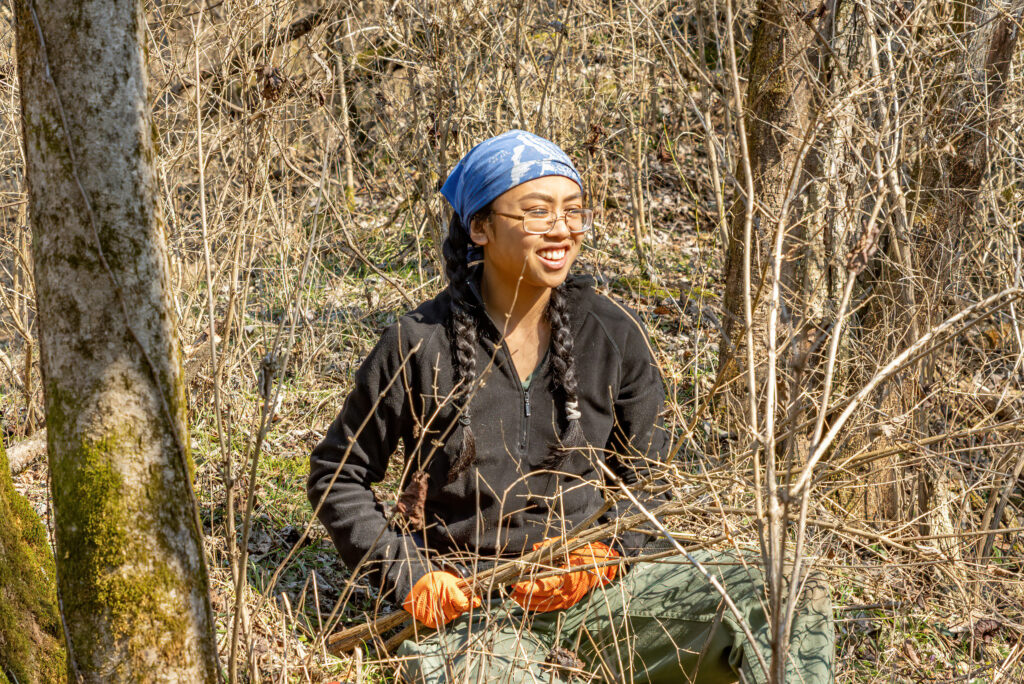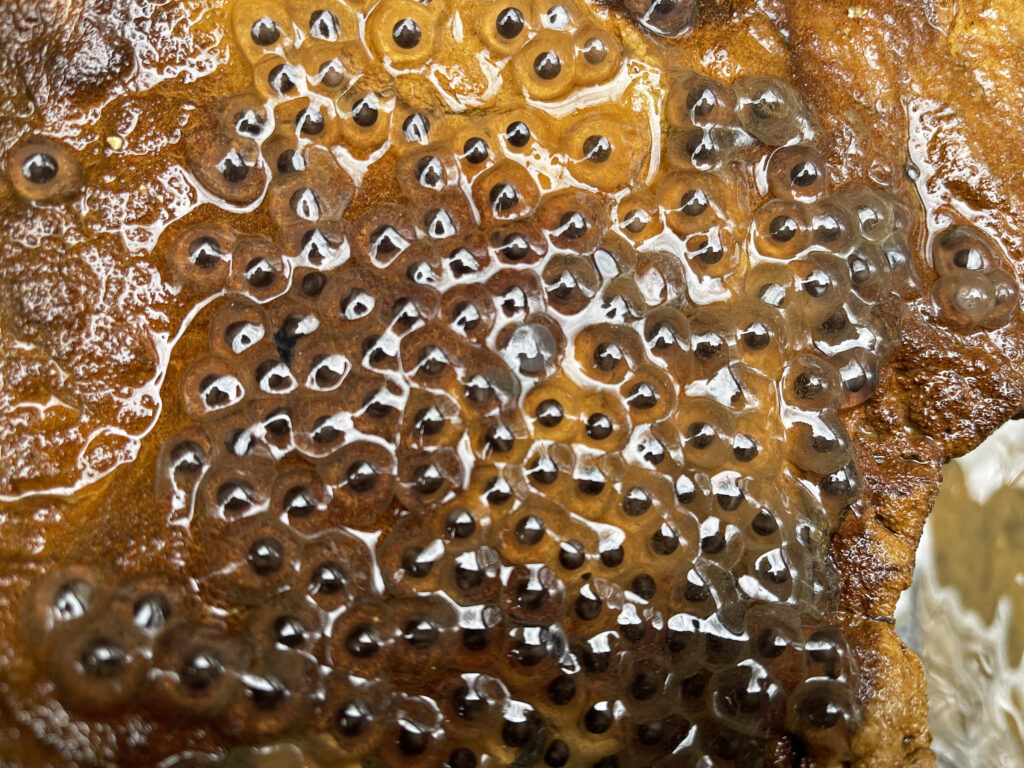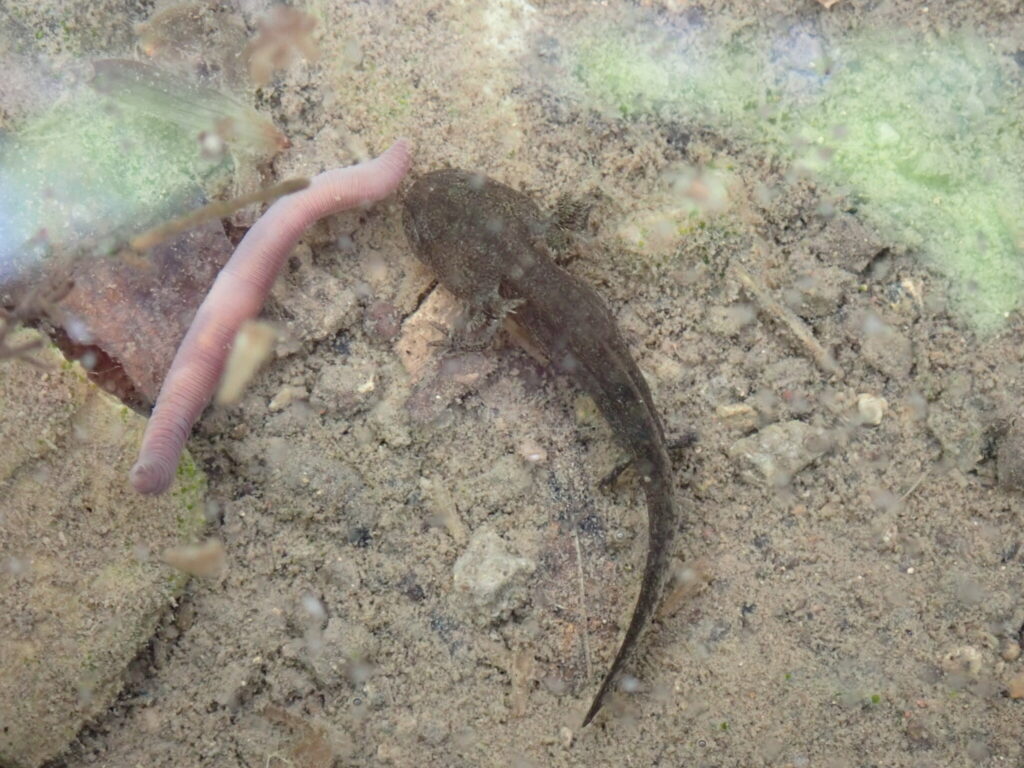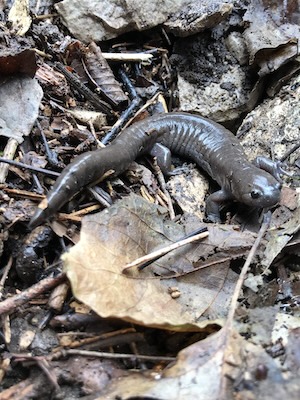Dani worked at Floracliff as a Land Stewardship Technician from December 2023 through January 2025. She wrote this piece for a Nature Writing class at the University of Kentucky and gave Floracliff permission to share it.

One afternoon in February I laid on my belly upon a damp dirt mound in a creek bed deprived of water. I peered beneath slabs of limestone, hoping for something amphibian. Beyond the chain link fence marking the edge of the nature preserve, the endless din of I-75 rushed through a wall of tall-growing honeysuckle. The border of Floracliff Nature Sanctuary stands just 100 feet from a busy interstate, in a region that is increasingly developing. Agriculture, materials extraction, and urbanization converge around this protected 346-acre patch of woodlands.
I sat up to get back to work. The banks of Dry Branch were overtaken by privet and bush honeysuckle. They formed a cavern where they grew tall, arching over the banks. Our task at the sanctuary was to clear a riparian buffer of invasive species, based on evidence that the leaves of honeysuckle can negatively impact the growth of aquatic wildlife. We wrestled with multiflora rose, sawed the invasives at the base and daubed their stumps with herbicide. The huge ones resisted coming down after they’d been cut, their limbs tangled with the arms of redcedar and other honeysuckles up in the canopy.

By the end of March we were focusing on a different invasive species, garlic mustard, downstream of the honeysuckle site. I took a break and walked down the hill to Dry Branch. The spring weather meant water was actually flowing through the creek, collecting in shallow puddles. I turned over a flat rock, and found a gelatinous, mucousy mass stuck to the bottom. Looking closer, I smiled as I realized what they were. Streamside salamander eggs. Each mass was a clear egg, inside each jelly orb swam a little larval salamander. The larvae danced, tails wriggling. I gently replaced the rock so the larvae were set back into the water.
The streamside salamander is most active during the winter months, where adults seek out ephemeral or intermittent streams in woodlands, pastures, or even rural subdivisions. There they breed and lay their eggs–choosing streams that dry up by summer to ensure that no fish will be around to eat their young. All month long I returned to Dry Branch, finding more eggs stuck to the undersides of slabby limestone rocks. Dry Branch flows into Falls Branch, a tributary of Elk Lick Creek. The creek’s pools and riffles wind through a steep valley towards the Kentucky River Palisades. Limestone outcrops tower over the river in this section, and the rich, calcareous soil forms the basis of a unique ecosystem home to species uncommon to the rest of the state. The range of the streamside salamander is restricted to central Kentucky, southwestern Ohio, and southeastern Indiana. Disjunct populations occur in West Virginia and middle Tennessee. This limited, fragmented range contributes to the threatened status of this cryptic amphibian.

At the end of April I spotted hatched streamside salamander larvae swimming freely in a couple of the ephemeral streams that feed into the palisades. They swam low above the leaf litter at the bottom of the stream, disappearing in a cloud of sandy debris when disturbed. They looked like tiny dark tadpoles, with oversized heads and vertically flattened tails, about half an inch long. As they grew closer to metamorphosis, little appendages developed on the sides of their bodies. Once I watched as a larval salamander sized up a pink aquatic worm that it was about the same length as. The salamander got a grip on the worm’s head and a comical struggle ensued. Eventually predator gave up on prey, but I was touched by the tenacity of the tiny larvae. In May I found them still swimming about, and I hoped they’d hurry and grow up before the Kentucky heat dried up the stream.
After springtime, signs of streamside salamanders become difficult to find. They develop quickly, eggs hatching one-and-a-half to two months after deposition. Depending on temperature, it takes four to ten more weeks for the larvae to reach metamorphosis. The adult salamander is dark, brown-grey, and speckled with blue-grey lichenlike patterns on its venter. Amphibians breathe through their skin, and high temperatures aren’t ideal for salamanders that can lose moisture through evaporative water loss. So adults burrow deep underground to wait out the summer. Some emerge as early as November, coming back to the stream to find a mate. This emergence is likely linked to rain events. Much about the lives of these fossorial creatures remains unknown. We do not know how far they tend to travel away from breeding streams to find a burrow, or their average lifespans. It is assumed that they burrow near their favored breeding sites, but they have been observed crossing country roads during cold-weather months. What is definitive is that these secretive salamanders overcome staggering odds to reach adulthood. Only five percent of the larvae I saw swimming in their eggs in March would reach metamorphosis. Though the total population is declining over its range, Ambystoma barbouri persists. Despite a heavy infestation of invasive plants and the nearby interstate which no doubt altered the hydrology of Floracliff’s creeks, adult salamanders returned each winter and entrusted their young to the intermittent streams of these inner Bluegrass woodlands.
Days grew longer, and Central Kentucky’s low-order streams ran dry. Cross-vine flowered high up in the summer canopy, and the streamside salamanders of Floracliff Nature Sanctuary burrowed in wait for cool, wet weather. I was hungry to know more about their lives and the current challenges they face. I headed to the Thomas Poe Cooper building, home of the University of Kentucky’s Department of Forestry and Natural Resources, to catch up with Steven Price, a professor of stream and riparian ecology. I asked Dr. Price about Ambystoma barbouri’s greatest threats in Central Kentucky. Here in the bluegrass, our landscape has been modified for hundreds of years, savannahs and canebrakes altered to make way for the development of cities and farmland. The streamside salamander is tolerant enough to have adapted to these changes, but there is a limit to the survival of the species. Development that reduces the quality of intermittent and low order streams sets back species survival, as does development without prioritization of riparian buffers. This development issue is especially relevant in Fayette County, with the Lexington-Fayette Urban County Government projecting continued population growth over the coming 20 years. Currently up for public comment is a 2023 recommendation by the city of Lexington’s planning commission to expand the urban service boundary by 2800 acres in order to accommodate 5 neighborhoods across the county. An expanding population contributes to an increased pressure to develop housing and roads in the Bluegrass region, pushing further out of the city center towards the rural stronghold of the streamside salamander.
Central Kentucky streamside salamanders compose the most robust segment of the species. What about the survival of the species as a whole, with its population fragmented across Tennessee, Ohio, Kentucky, Indiana, and Illinois? The segmented nature of the species’ distribution constitutes a major challenge for streamside salamander conservation, threatening the genetic diversity of the species. Researchers focusing on the Tennessee segment of the streamside salamander population report declining populations in the face of increased development, landing the salamander on the state endangered species list. Streamside salamanders in this state are found in the Central Basin region, which is underlain with limestone geology. Humans, too, are drawn to build and farm in the central basin. This region is home to Nashville, the most populous city in Tennessee. The previous year saw a population increase of over 30,000 new residents in the Central Basin region, with continued growth projected in the area. A shrinking salamander population as a result of human development contributes to a shrinking genetic pool, which leaves the species less equipped to respond to modern challenges. Lack of genetic diversity means lower adaptive ability and a greater chance for the expression of deleterious traits. “Prior genetic work has provided… evidence for low genetic connectivity among subpopulations,” writes Marc Beer, a professor of landscape genomics at Washington State University. “Limited genetic diversity within some subpopulations of A. barbouri suggests range shifts in response to climate change are unlikely.” The disjunct salamander populations of West Virginia and Livingston County, Kentucky also face these hurdles, as these populations face less genetic diversity than the continuous Central Kentucky population.
Increasing urban development and species fragmentation combine with the effects of climate change to challenge the survival of Ambystoma barbouri. According to a report from the United States Geological Survey, climate-change factors that could impact this species include increasing temperatures, heavy precipitation events, and decreasing precipitation-to-evapotranspiration ratio. Though climate change models predict increased frequency of heavy rain events, models also predict overall precipitation will decrease in proportion to water loss from the land through evaporation and transpiration. We may see less rain falling annually, but the rain that does fall will be concentrated into heavier, more impactful storms. Within the range of A. barbouri, USGS models predict more frequent, more severe, and longer droughts. This combination of conditions could contribute to detrimental landscape changes. Streams could dry faster than larvae can reach metamorphosis, or larvae could be forced to metamorphosize earlier than ideal, leading to future fitness costs. Higher peak flows of streams from significant storms could wash larvae into higher-order creeks where fish prowl for prey, or flush increased chemical run-off or sediment into first or second-order streams. Increasing temperatures could contract the habitable range of the streamside salamander, which is already broken up with small disjunct populations. Climate change will exacerbate all stressors that the streamside salamander faces, especially when salamander populations exist near urban centers.
The human populations of Central Kentucky and middle Tennessee’s Central Basin are growing. There’s no rewinding the ecological clock to pre-settlement times, so we must accept that human development in streamside salamander habitat will continue, and devise ways of safeguarding critical habitat around our developments. One path forward is federal protection under the Endangered Species Act. In 2010, the United States Fish and Wildlife service first received a petition listing Ambystoma barbouri as a candidate for endangered or threatened status do my essay. The agency approved a 12-month finding period, which is meant to allow for research into a candidate species’ ecology and threats, and also includes public comment and hearings. Since then, A. barbouri has wriggled through a series of decisions at the federal level that have kept the species’ status under review for the past 14 years. Another 12-month petition finding was found to be warranted as of September of 2024. Granting this salamander federal threatened status would afford the species the protection of the Endangered Species Act, allowing for USFWS to closely scrutinize a threatened species’ biology, conservation needs, and threats to determine what activities must be regulated to ensure conservation. This could include the designation of critical habitat, which is crucial due to the fragmentation of the streesamside salamander’s range. A blanket federal protection for streamside salamanders would be advantageous to the most isolated populations of the species, like the population found in West Virginia. To get there, public pressure could sway the USFWS to expedite the decision-making process. However, I’m not sure the average Fayette County resident knows what a streamside salamander is, what one looks like, or where they live. Environmental education efforts highlighting the rich biodiversity of the inner bluegrass would help bolster public support for federal protection of the streamside salamander.
The journey to federal protection has so far been a slow crawl spanning more than a decade. Attempting to decode the bureaucratic world of environmental impact statements, 12-month findings, and 4(d) rules feels like facing down a thicket of honeysuckle armed with a pair of safety scissors and a butter knife. When environmental action on the federal scale stalls, we must turn to our communities to make a difference for our fellow forms of life. Andrea Drayer and her colleagues at University of Kentucky’s Price Lab for freshwater ecology studied streamside salamander abundance in north-central Kentucky. Their findings showed the greatest abundance of salamanders in forested streams, which underscores the importance of high-quality forested preserves in the conservation of this species. Drayer and her team suggested that preserving forested core habitats and a buffer of at least 450 meters from breeding-site streams would likely protect a significant portion of Ambystoma barbouri populations. This protection is already underway at local sites like Raven Run Nature Sanctuary and Floracliff. These critical refugia become more important as the force of anthropogenic development and climate change continue. They are patches of woodland where people can connect to native wildlife, and learn more about wildlife conservation. Donating to or volunteering with these sanctuaries presents a tangible opportunity to get involved in conservation. Volunteers at Floracliff Nature Sanctuary focus efforts on invasive plant removal in order to support the flourishing of native plants that wildlife like the streamside salamander co-evolved with. Recent amphibian conservation research from Eastern Kentucky University revealed that decomposing leaves of Amur honeysuckle, a ubiquitous invasive throughout the Bluegrass region, inhibits the body size and survival of northern cricket frog larvae. Because of the density of Amur honeysuckle infestations, the recently-fallen leaves of this invasive species can easily become the dominant portion of leaf litter in an infested area. This ubiquity combined with the high rates of detrimental chemical compounds found in the leaves contributes to poor stream quality and inhibits the growth of native plant species. The EKU study described negative impacts of honeysuckle chemical compounds on macroinvertebrates as well, which are a vital food source for many stream-inhabiting species. The restoration efforts of volunteers also liberate spicebush and young ash seedlings from the closed, dense canopy formed by thickets of honeysuckle. The benefits of conserving one amphibian species at a nature sanctuary radiates out to many other species of native wildlife. Volunteering closer to urban centers makes a difference, too. Streamside salamanders have been reported at Lexington’s Shillito Park, which sits just on the edge of New Circle Road, a heavily-traveled thoroughfare. Increasing the accessibility of volunteer days throughout Lexington-Fayette’s natural areas would help connect city residents to the biodiversity of the land they inhabit, which would develop a culture of stewardship throughout the Bluegrass Region. Amplifying the mission of Central Kentucky nature sanctuaries could benefit both the preserves and the streamside salamander by potentially allowing staff and researchers more resources to safeguard high-quality habitat and monitor the health of the species.

The vitality of Ambystoma barbouri as a species may be tied to tireless volunteer efforts to rehabilitate core habitat and to our investment in nature sanctuaries set aside to protect such habitats. In Kentucky, many groups work behind-the-scenes to manage preserves, and some are dedicated to acquiring more land to set aside for conservation. In the Kentucky River Palisades region, places that preserve A. barbouri’s forested core habitat include Floracliff and Raven Run, as well as Sally Brown-Crutcher Preserve and Dupree Nature Preserve. Floracliff is a private non-profit preserve, purchased piece-by-piece from 1958 to 1989 by a former Georgetown College professor of Biology, Mary Wharton. Funds from the Kentucky Heritage Land Conservation Fund (KHLCF) helped expand the preserve in the 21st century. Raven Run is administered by the city of Lexington, and was also expanded with funds from the KHLCF. Dupree and Sally Brown-Crutcher were named after the individuals that donated their wealth to establish these preserves, and are administered by The Nature Conservancy, a global biodiversity-focused organization. The generosity of forward-thinking visionaries, founders, and donors has paved a path towards a more biodiverse future. These preserves are crucial to safeguarding the woodland streams that A. barbouri depends on as development diffuses beyond urban boundaries. Kentucky Natural Lands Trust is another organization that works to keep intact Kentucky’s ecologically-functioning natural systems. Since 1995, this group has protected over fifty thousand acres of Kentucky’s natural heritage. Widespread public recognition for the work of these places and the trusts and conservancies that support them could encourage more folks to donate their efforts, funds, and land to supporting local natural areas.
Despite watching over a cohort of streamside salamander larvae all spring at Dry Branch, I have yet to see an adult streamside salamander. At the end of one late January day my partner came home from his job at a horse farm in Midway, Kentucky, and described uncovering an adult secreted in the mud beneath a limestone slab in a small stream on the property. The stream feeds into Elkhorn Creek, which winds its way, of course, to the Kentucky River palisades. “It was delightful,” he reflected, “Like Christmas morning after you open all your gifts, but then there’s one more little present nestled under the tree.” He showed me a picture, and I grinned when I saw the plump body of the salamander curled up in the palm of his work glove. Glee is something slimy, the color of oak leaves in decay, with shimmery-silver legs and toes, and round little amphibian eyes. Becoming acquainted with wildlife like the streamside salamander delivers to me a sense of optimism in conservation. They are declining in numbers, but somehow they have adapted to urban and agricultural habitats in Central Kentucky, in spite of the pavement and the tillage and the channelization and the atrazine run-off. The triumph of the life of a streamside salamander grants me a resolve to work towards this species’ conservation. There’s so much evidence that the salamander will thrive if given the space and protection. Under federal protection, perhaps all segments of the streamside salamander population across its five-state range could see stabilization or even an increase in numbers. Nature sanctuaries of the private, state, and federal persuasion can be better supported to prioritize the restoration of high-quality habitat. Invasive species management projects can involve the human community in enhancing the resilience of the low-order streams critical to salamander reproduction. But since the streamside salamander can live in close proximity to human agriculture and housing, educating property owners on best practices to preserve stream health and salamander habitat would also benefit the species’ survival.
Born of whorled and bone-smooth limestone, the calcareous soils of the palisades region support a diversity of life on the outskirts of one of Kentucky’s major centers of human development. The fate of the streamside salamander in central Kentucky and surrounding states depends on our willingness to keep segments of our built environment wild enough to sustain the life forms that remind us of our feral past. Having sanctuaries to share with threatened species prompts us to remember our duties as humans. We subdue the earth, dredge energy from its depths, and flatten out its contours when we fell timber and expand our suburbs. Now is the time to even the score and act in service of the earth and its inhabitants.
References
Wharton, Mary E, and Roger W Barbour. Bluegrass Land and Life: Land Character, Plants, and Animals of the Inner Bluegrass Region of Kentucky: Past, Present, and Future. 1st ed. Lexington: The University Press of Kentucky, 2015. Print.
Drayer, Andrea N, Jacquelyn C Guzy, and Steven J Price. “Factors Influencing the Occupancy and Abundance of Streamside Salamander (Ambystoma Barbouri) in Kentucky Streams.” Journal of herpetology 54.3 (2020): 299–305. Web.
Lyons, et al. “Potential Effects of Climate Change on Ambystoma barbouri (Streamside Salamander).” United States Geological Survey. 5 April 2023, https://pubs.usgs.gov/publication/ofr20211104C
“Lexington Urban Growth Master Plan.” 2024 Urban Growth Master Plan, Lexington-Fayette Urban County Government | Division of Planning, 30 Sept. 2024, www.urbangrowthlex.com/.
Hubbs, N Wade et al. “Conservation genomics of urban populations of Streamside Salamander (Ambystoma barbouri).” PloS one vol. 17,6 e0260178. 30 Jun. 2022, doi:10.1371/journal.pone.0260178
Beer, Marc A et al. “Landscape Genomics of the Streamside Salamander: Implications for Species Management in the Face of Environmental Change.” Evolutionary applications 15.2 (2022): 220–236. Web.
“Our Work.” Kentucky Natural Lands Trust, 20 July 2023, knlt.org/our-work/.
“Kentucky Heritage Land Conservation Fund.” Kentucky Energy and Environment Cabinet, https://eec.ky.gov/Nature-Preserves/conserving_natural_areas/KHLCF/Pages/heritage-land-conservation-fund.aspx.
“Dr. Mary Warton.” Floracliff Nature Sanctuary, https://www.floracliff.org/dr-mary-wharton/.
“Sally Brown and Crutcher Nature Preserves.” The Nature Conservancy, https://www.nature.org/en-us/get-involved/how-to-help/places-we-protect/sally-brown-nature-preserve/.
“Dupree Nature Preserve.” The Nature Conservancy, https://www.nature.org/en-us/get-involved/how-to-help/places-we-protect/dupree-nature-preserve-profile/
Holomuzki, Joseph R. “Macrohabitat Effects on Egg Deposition and Larval Growth, Survival, and Instream Dispersal in Ambystoma Barbouri.” Copeia 1991.3 (1991): 687–694. Web.
Robison, et al. “ Impact of invasive Amur honeysuckle, Lonicera maackii, leaf litter on multiple trophic levels of detritus-based experimental wetlands.” Freshwater Biology. 2021; 66: 1464–1474. https://doi.org/10.1111/fwb.13731
United States Department of the Interior, Fish and Wildlife Service, “Endangered and Threatened Wildlife and Plants; Partial 90-Day Finding on a Petition To List 404 Species in the Southeastern United States as Endangered or Threatened With Critical Habitat.” Vol. 76 Fed. Reg. No. 59836 (September 27, 2011).